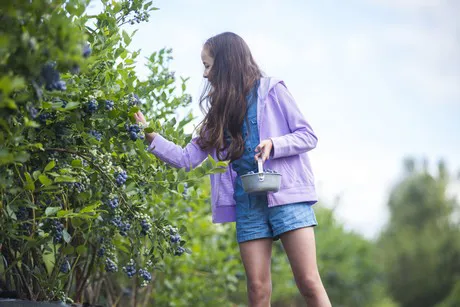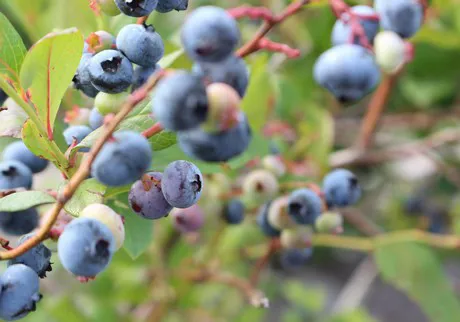Marketing blueberries to the foodservice industry has been part of the US Highbush Blueberry Council's (USHBC) efforts for more than a decade now. The organization has also turned their attention on helping bring more blueberries into US schools. In recent years the efforts have been aimed at covering as much of the US school system as possible in order for more schools to adopt blueberries as part of their regular menus.
"The Blueberry Council started marketing to foodservice professionals back in the mid-2000s," said Victoria De Bruin, Marketing Manager of the USHBC. "Since then, foodservice – which includes school foodservice – has remained a key component of the USHBC’s annual promotional program. In schools, our primary focus has continued to be large school districts with higher-than-average student reach. We’ve maintained several tactics for years, mostly adjusting which districts and schools we’d be reaching, making sure each region of the country is getting the attention and key messaging our members rely on – as part of a fuller marketing mix – for localized interest."
Why are blueberries ideal for school foodservice?
More schools are looking to add healthier options to their menus. Increased consumption of fruits and vegetables are often interlinked with this goal. The Blueberry Council presented several practical reasons why blueberries would be a good fit in school foodservice programs beyond the health benefits. One of the reasons it stated was the overall popularity of blueberries in the market.
"Consumers of all ages love blueberries," De Bruin noted. "Our most recent consumer usage and attitude study conducted in 2017, showed that blueberries are consumers’ top berry – plus, their presence makes menu items more appealing."

De Bruin added that ease of preparation as well as broad availability made blueberries an easy pick for many schools. "Beyond the numbers, blueberries are excellent for school foodservice because they’re low labor (no pitting, chopping, peeling) – and can be cross-utilized across meal parts (breakfast, lunch, snack, in both sweet and savory applications)," she said. "Plus, blueberries add a health halo to any menu item. Highbush blueberries specifically are an ideal commodity to support USDA’s Farm to School grant program because of its availability nationwide. The USDA offers fresh and frozen blueberries, blueberry yogurt cups, and mixed berry cups, so there are many versatile ways to get the most out of procurement."
The 'Farm to School Playbook'
This past summer, the USHBC took another initiative and introduced the 'Farm to School Playbook' to US schools. The Playbook was launched as part of the USDA-funded Farm to School program. This program encourages schools to connect with local growers and the Playbook was designed as a digital resource for schools to gain more information about blueberries. The Farm to School Playbook can be found on the Blueberry Council's website.
"Through the Farm to School program, and National Farm to School Network, we are encouraging schools to connect with their local blueberry growers and understand the life of a blueberry from farm to fork," De Bruin explained. "It’s a lesson plan in and of itself. The Blueberry Council created a Farm to School Playbook to share educational materials about how blueberries are grown, instill a sense of pride and support for local blueberry growers among schools and students alike, and demonstrate how blueberries can be enjoyed year-round through the cost-effective USDA entitlement program. It is a digital resource that was created to serve as the new go-to resource for schools that are interested in menuing and educating their students about highbush blueberries. For USHBC, education will be the focal point."
De Bruin continued by highlighting the success of the program so far. "The Playbook lives on www.blueberrycouncil.org and can be directly accessed via www.blueberriesinschools.com – our plan is to use and evolve this tool well beyond this first year. While some schools are just starting their Farm to School program, others are excelling with successful nutrition education programs. Our Playbook was designed to address all steps of the journey. The Playbook resources cover everything from educational activities for kids, tips on maximizing procurement, handouts for parents, tips for arranging blueberry taste tests, tips for washing and caring for blueberries, and inspiration for school menus."
Plans for 2019
The Blueberry Council is now looking ahead to what the next 12 months will entail for the school programs. Work will continue in promoting the Farm to School Playbook, as well as other strategies to encourage more schools to carry and prepare blueberries for kids. The aim is that subsequently, children will engage more with the food they eat and be familiar with where it comes from as well as the health benefits.
"The Blueberry Council’s 2019 school foodservice program will focus on further promoting the Farm to School Playbook that we developed to support the popular USDA Farm to School grant program," De Bruin shared. "We launched and concluded three in-school promotions in 2018 that will be developed into case studies and be shared to inspire other schools that are considering a blueberry promotion in 2019. We are also planning to develop 'Blueberry Promo Kits' with new kid-friendly signage to share with schools looking to implement their own in-school blueberry program. Additionally, we’ll continue a digital partnership with the National Farm to School Network to promote use of the USHBC Playbook among this premier Farm to School community."
She concluded, "The USHBC wants to inspire and support schools across the country to add more highbush blueberries to their menus and educate children about the origin of the foods they eat."
For more information:
US Highbush Blueberry Council
Tel: +1 (916) 983-0111
www.blueberrycouncil.org/contact
